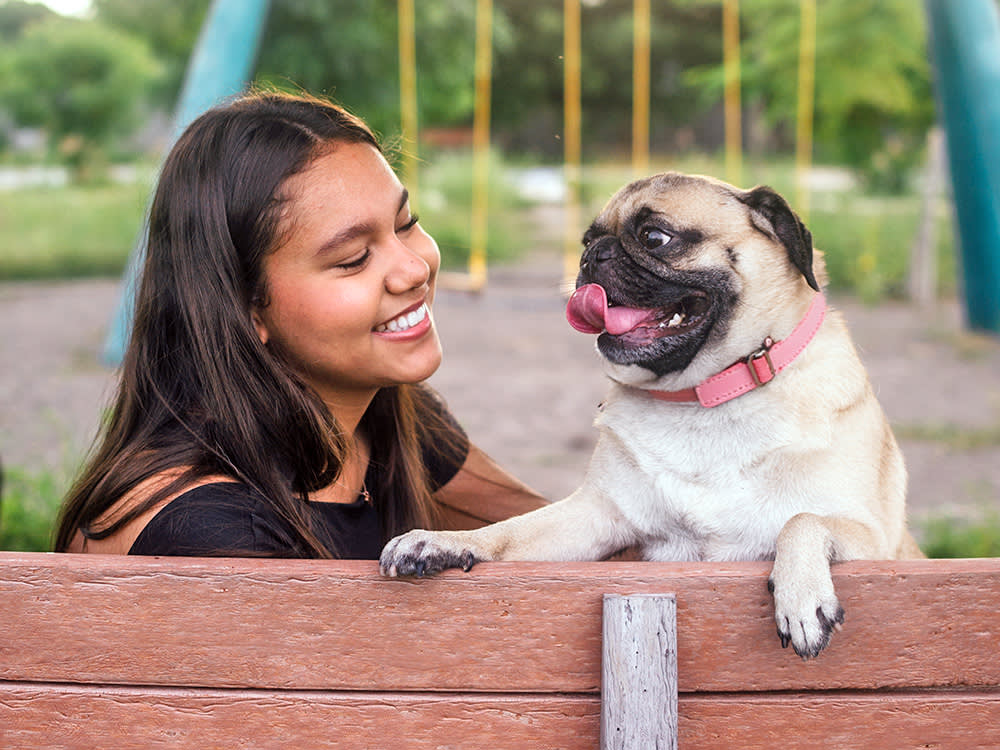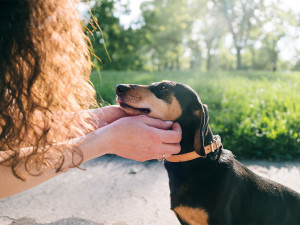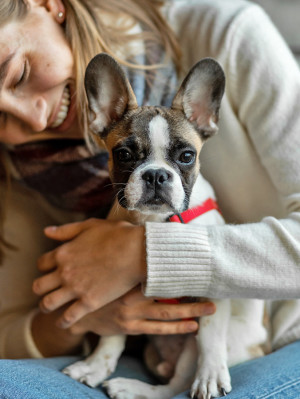A Dog’s Head Shape Actually Affects Their Personality, New Study Finds
Are some dogs just friendlier by nature?

Share Article
You don’t have to scroll on TikTok longer than 30 seconds to find out how beloved flat-faced dogs are — in fact, French Bulldogs were the most popular dog breed of 2024opens in new tab. That popularity comes at a price; breeding for those squishy faces is a harmful practice that often leads to devastating health consequences for these short-nosed (aka “brachycephalic”) pups. All the same, 93 percent of flat-faced pet parents would want a dog of the same breed in the future, partly because they have a reputation for being calm, friendly, and good with children.
In a new study, opens in new tab researchers set out to determine whether or not these personality differences are really due to brachycephalic dogs’ face shape. They found that flat-faced dogs have some innate personality differences, but training and upbringing are more important than genetics.
Researchers gave two surveys to the pet parents of over 5,000 purebred dogs. The first examined four personality traits: calmness, trainability, sociability, and boldness (aka courage and confidence). The second assessed 12 behavioral problems. In their analysis, researchers focused on the top four most commonly reported: jumping on people, pulling on the leash, being too reactive when guests arrive, and not coming when called.
They found that short-nosed dogs are calmer and bolder than long-nosed dogs. But they had their own problems, too: They were harder to train, more likely to overreact when guests arrive, and less likely to come when called.
How much do you spend on your pet per year?
However, genetics aren’t the only thing playing a role. Researchers found there were several common environmental factors that contribute to flat-faced dogs’ behavior. “Brachycephalic dogs were more likely to be kept solely as family companions, to receive no formal training, to be housed exclusively indoors, to have daily walks shorter than an hour, and to be allowed on the owner’s bed,” lead author Borbála Turcsán wrote. Their pet parents were also more likely to fall within the 19-30 age group.
These environmental factors may cause their own sets of problems. When researchers conducted statistical analyses, they found that certain factors weren’t actually tied solely to head shape. “We found that the low trainability of short-nosed dogs is mainly due to their small body size and lack of training — not their head shape,” Turcsán told Phys.orgopens in new tab. “When we control for these influences, there’s no difference in trainability across head shapes.” Additionally, short-nosed dogs originally appeared to be more social than long-nosed dogs — but when the researchers controlled for other variables, they determined that this was likely due to the youth of the flat-faced dogs who participated, since puppies are generally more social than older dogs.
In the end, a few behavioral traits did seem to depend on head shape. “Calmness, boldness, and poor recall response are all traits specific to short-headed dogs,” Turcsán told Phys.orgopens in new tab. “These behavioral traitsopens in new tab are directly connected to head shape and remain significant even when we control for background factors.”
This may be because short-nosed dogs have more rounded brains, which could lead to different behavioral regulation. Their poor health could contribute, too. “It’s also possible that dogs with breathing difficulties, pain, or musculoskeletal issues move less and seek comfort, which owners interpret as calm behavior,” Turcsán told Phys.orgopens in new tab.
No matter how calm a dog’s genes may make them, the researchers’ key takeaway is that training matters most — especially for a type of dog that is typically pampered. Even positive genetic traits can’t come to light without the right environment. “Our results highlight that even for small-sized brachycephalic dogs, proper training — rather than indulgence — is essential for fostering positive behaviors,” Turcsán wrote. “Given the rising popularity of these breeds despite their well-documented health and welfare challenges, a better understanding of their behavior could support responsible ownership and training practices, ultimately contributing to the long-term welfare of these dogs.”

Sio Hornbuckle
Sio Hornbuckle is the Assistant Editor at Kinship, where they frequently write for the site. As a writer, they specialize in pet news, animal science, and pop culture. They live in New York City with their cat, Toni Collette.
Related articles
![Girl sleeping with her French Bulldog dog in bed.]()
A New Study Finds Flat-Faced Dogs Get Pretty Crappy Sleep
It’s one of several health problems facing brachycephalic breeds.
![A woman holding a French bulldog over her shoulder.]()
Bulldogs and Other Flat-Faced Breeds Are Being Banned. Here’s Why
Breeds with those squished-in faces are charming — but their health issues are not.
![Hands of an unrecognizable woman are petting small Dachshund dog in the park.]()
Small Dogs With Long Noses Live the Longest, New Study Finds
Scientists are seeing some trends when it comes to pup mortality.
![Woman and her pet Pug dog at home.]()
What Is “Snurfling,” and Why Do Dogs Do It?
Not all dogs make this noise, but you know it when you hear it.
![Woman holding her frenchie dog on her lap.]()
French Bulldogs Are Flooding Shelters—What to Know Before Adopting One
They’re the most popular dog of the year, and you don’t have to go to a breeder to find one.




